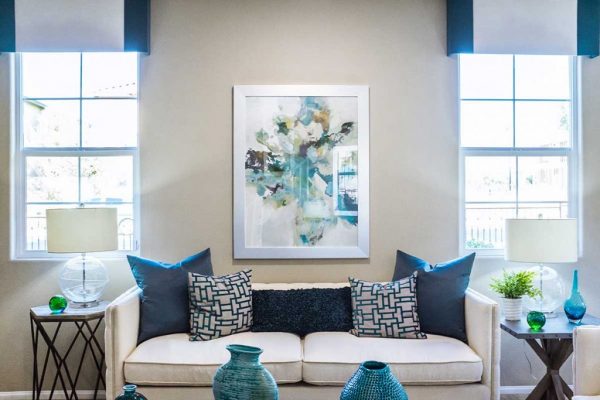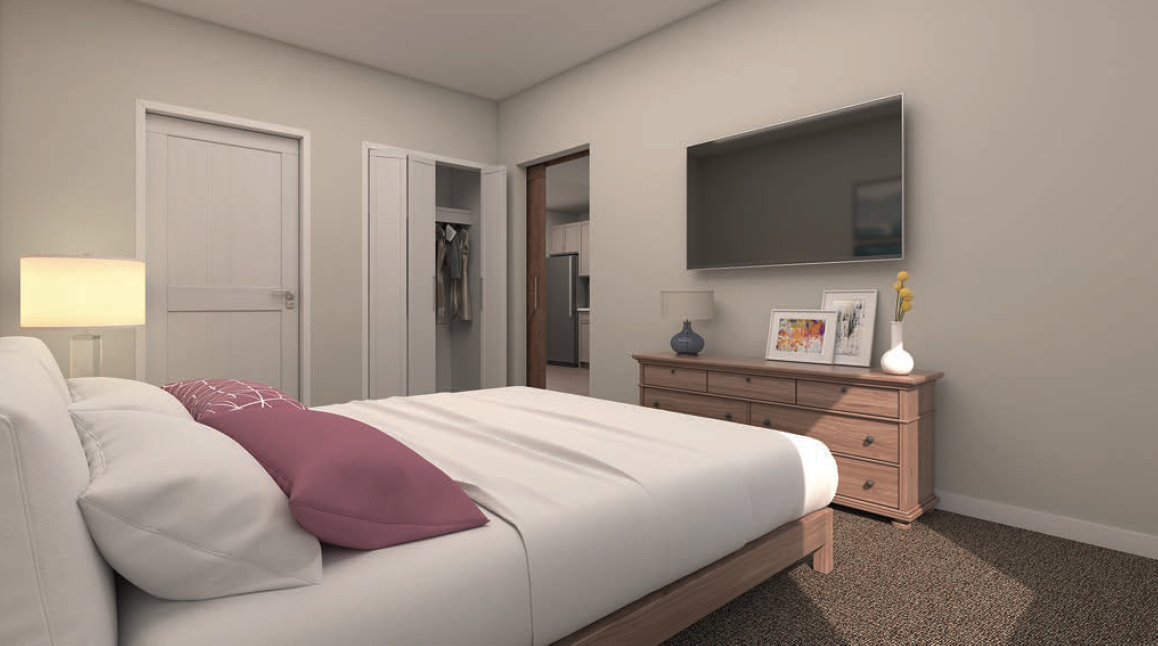
Find Independent Living Near You
Search Independent Senior Living Housing
Independent living is a type of senior living community, or retirement home, that empowers seniors to live independently through dining, housekeeping, maintenance, and social activities and amenities to support a maintenance-free lifestyle.
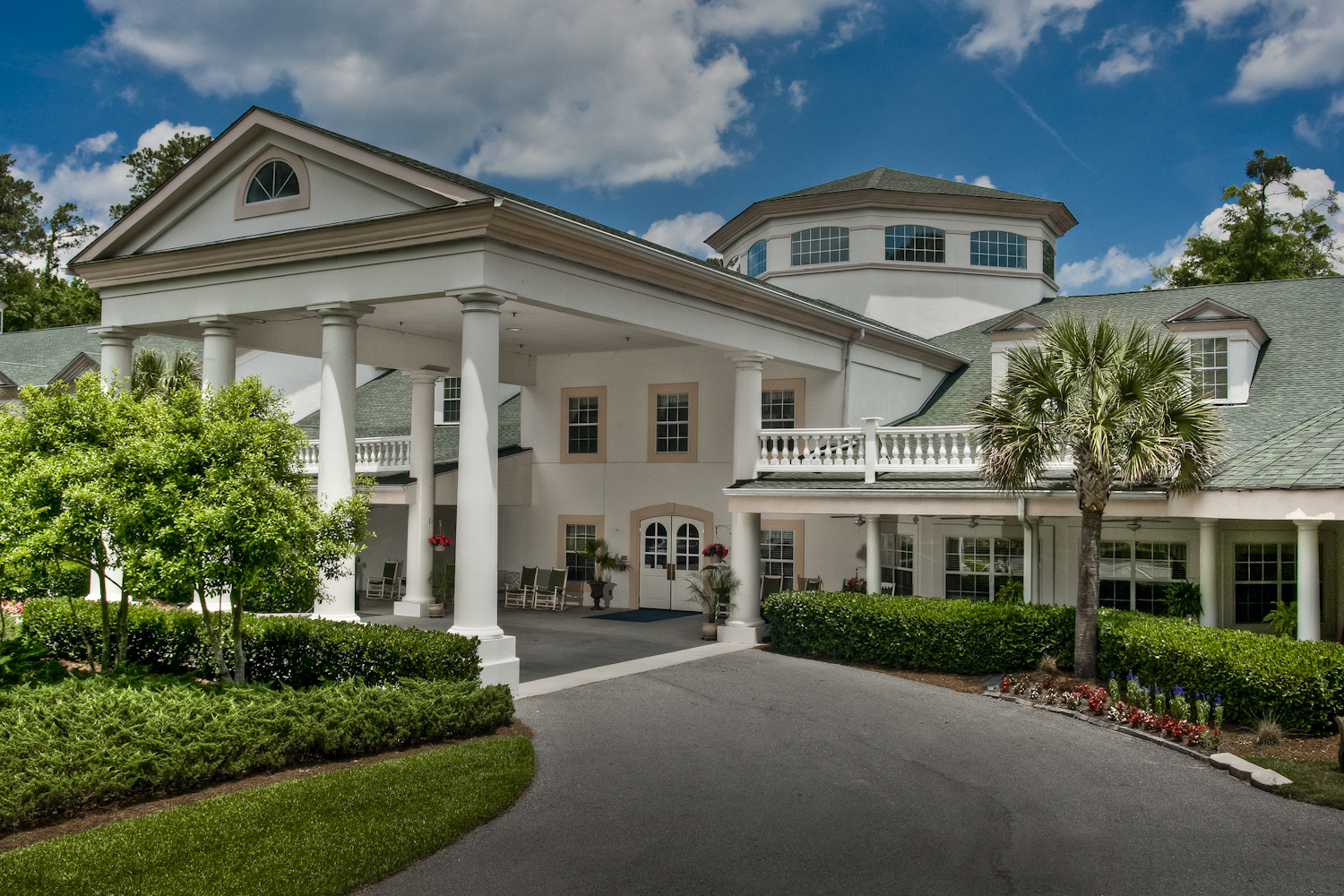
Independent living and memory care community - Bloom at Belfair
Independent living is a lifestyle choice. Do you want to keep shoveling snow, cooking and cleaning up after meals, mowing the lawn, and cleaning your house? Or, would you rather enjoy rich social activities with your peers without all of the hassle? The senior living industry calls this a maintenance-free lifestyle; we call it the good life.
This lifestyle choice, and the rich amenities and services that come with it, often distinguish independent living from the other types of senior housing.
Other types of senior housing require care and are centered around that care. Providing this care may require a more institutional environment, which can be very different from the attractive amenities in independent living.
For instance, nursing home residents require 24/7 nursing care in an institutional environment. Assisted living residents need personal care services to get assistance with the activities of daily living. Memory care residents suffer from dementia or Alzheimer's. Unlike those types of senior living communities, independent living communities are not typically licensed to provide any care.
Since seniors are aware that their needs will change over time, independent living communities that are part of a larger senior housing campus can be popular, because they offer multiple levels of care. This way a senior can move to the senior living campus' independent living building when they're independent, then move into assisted living when the resident needs personal care services, and then move into the nursing home when the resident's care needs grow further.
The senior living industry calls this aging-in-place. Many senior living thought leaders consider this a more ideal setup, since it minimizes stress on the resident and his or her family by preventing multiple moves.
These senior housing campuses may offer different housing options including independent living cottages/apartments, assisted living apartments, memory care apartments, and a nursing home rooms. However, there is typically a main apartment building or clubhouse where all of the key amenities (dining rooms, fitness center, computer lounge, etc.) are located.
Continuing care retirement communities (CCRCs) are a type of senior housing campus that offer multiple types of care on the same campus, but CCRCs also have a unique financing model. CCRCs require a large upfront fee known as an entrance fee in addition to monthly fees. The entrance fee may be refundable, partially refundable, or non-refundable.
Many CCRCs are Christian communities, Jewish communities, or focus around a core group of people, such as Elks Club members. Other CCRCs are not associated with any particular group of people.
Other senior living campuses may offer similar care levels, amenities, and services, but with a much smaller upfront fee called a community fee. So, you can find senior housing campuses with multiple types of care that either use the CCRC model with the large entrance fee or don't use the CCRC model, but instead charge a smaller fee called a community fee.
Independent living communities are often similar to large apartment buildings, but they usually have unique features and amenities designed to empower the senior living residents. For instance, the community may feature a central dining room where residents may enjoy restaurant-quality meals together. Other features may include a fitness center, pool, library, computer lounge, game room, theater, chapel, and many more. The main building with dining and other amenities is often the center of life in a senior living community and may offer much greater socialization than being alone at home.
What is Included in Independent Senior Living?
Independent living communities typically provide housing, 1-3 meals daily, housekeeping, maintenance, transportation, and social activities. These services can vary greatly in quality and cost from community-to-community.
Usually Included in Senior Independent Living:
- Housing - apartment or cottage
- Dining - 1-3 meals daily
- Housekeeping
- Laundry services
- Maintenance
- Transportation
- Social activities
Housing
Housing in an independent living community is typically an apartment (studio, one-bedroom, or two-bedroom), cottage, or more rarely a single-family home. There is usually a central hub or community building where the most important amenities and services are located: dining rooms, fitness centers, game rooms, computer lounges, pools, etc. These communities are designed to offer the privacy and comfort of a private residence, while providing the social and other benefits of being part of a larger community.
Independent living housing comes in a number of different forms and sizes. Apartments as part of a larger community are the most common, but many independent living communities also offer cottages or townhomes that are usually single-story and in close proximity to the main community building. In rare instances, an independent living community will offer single-family homes.
Independent living apartments vary in size, number of bedrooms, number of bathrooms, and the size of kitchens included. Studio and one-bedroom apartments are common, but many new communities offer two-bedroom apartments; three-bedroom apartments can be found in a handful of luxury communities. Independent living apartments usually range in size from 350 sf to 1,400 sf or more.
Dining
Dining in an independent living community is often served restaurant-style with one to two seatings in a large dining room. Meal quality and quantity varies by community, but most communities serve a variety of entrees to residents and a selection of sides. There are often a number of always-available items such as popular sandwiches, salads, or other items: in case you are looking for some comfort food.
Offering multiple dining venues is a hot trend in senior living, so some independent living communities have cafes, coffee shops, and bistros on site. These venues will offer a variety of sandwiches, salads, soups, or breakfast selections that may not be available in the main dining room. Many residents find it helpful to have a less formal option to change things up.
Family or private dining rooms are often available as well. In these cozy areas, you can invite friends or family for a birthday celebration or special dinner with more privacy.
Since high-quality food can be a major draw for seniors, many independent living communities have begun to raise the bar in terms of food quality and dining experience. Today it is not uncommon to hear about wood-fired pizza ovens, cafes, coffee shops, or menus tailored to the specific whims of seniors. These offerings may feature a greater number of high-quality meats and fresh produce that are skillfully prepared. This quality increase, however, may come at a cost with higher rents in some of these communities
Also, many independent living communities try to accommodate for special diets, such as vegan, vegetarian, kosher, low-sodium, or heart friendly diets. There can be a big gap in the selections offered for these various diets, so check with the senior living communities that you're interested in to understand what's truly available.
We always recommend that you have one or two meals at a community before making the move. While many independent living apartments have kitchens, you'll invariably end up eating many meals in the common dining rooms, if not for the food then just to socialize. In that case, you'll want to make sure that it's somewhere that you'll want to eat often.
Housekeeping
It's common for light housekeeping to be included in independent living facilities. More thorough cleans are typically available at an extra charge.
Laundry Services
Many independent living apartments have washers and dryers, so some senior residents do their own laundry. Other independent living residents pay an additional fee for the community to do the resident's laundry.
Maintenance
Maintenance is nearly always included in independent living, even if you're living in a cottage and not an apartment. This includes community maintenance such as snow removal, landscaping, mowing, but it also includes maintenance within the apartments and cottages. Having a maintenance-free lifestyle is a major selling point made by independent living providers.
Transportation
Scheduled transportation is frequently offered in independent living communities. These scheduled trips may go to local shopping centers, restaurants, doctors' offices, churches, theaters, and more. Special trips outside the schedule or beyond a certain distance may come at an extra charge.
Some communities offer car-service for more personal transportation. For instance, the community may have an old Chevrolet or a town car that will take couples to the local theater.
Social Activities
Socializing with your peers can be one of the most compelling parts of living in independent living. Some communities feature trips to local sporting events, live theater, or dinners out to favorite restaurants. Other activities are within the community, such as musical performances, fitness classes, movies, themed dinners, card games, classes, and more. Check-out the community's independent living calendar to get a sense of what activities are available.
What Does it Cost to Live in Independent Senior Living Communities?
Key Points
- Independent living costs approximately $3,300 per month on average in the United States
- Cost varies greatly by city and quality of services/amenities provided
- Range is $2,500 - $7,000+ per month
- Independent living may require additional monthly fees
- Medicare and Medicaid do not pay for independent living
Average Cost of Senior Independent Living
The average cost of independent living is approximately $3,300 per month according to NIC.
Please note that the $3,300 average may be a little high, since the figure includes some assisted living apartments within an independent living community.
This cost varies greatly by region or even within a city depending on a number of factors including level of competition, quality of provider, amount and types of services and amenities offered, and care needs of the senior resident.
Independent living is often cheaper for the same type of unit than assisted living. This is because independent living does not include levels of care for personal care services and does not include medication management.
Independent living costs can climb, however, as you go from smaller apartments (studios) to larger apartments (1, 2, or 3 bedroom apartments) or cottages; unfortunately, the penthouse that you're looking for comes at a cost. Also, communities with more luxurious amenities and services are more expensive.
Independent living offered as part of a continuing care retirement community (CCRC) may be more expensive, but it may offer more amenities and more care services on the same campus including assisted living, memory care, and a nursing home. The upfront entrance fee for an independent living community as part of a CCRC campus often costs over $100,000, which may or may be not refundable. In addition, ongoing rent payments of $4-5,000+ per month.
Independent living, however, comes in many shapes and sizes. It's not a requirement that independent living be part of a CCRC to offer rich amenities and additional types of care, neither is it a requirement that CCRCs be expensive. The devil is in the details as you compare communities.
More affordable independent living communities may charge a much lower rate of $2-3,000 per month for a studio or one-bedroom apartment. These communities offer the bare essentials in terms of service, putting more of the service onus on the senior residents and their families, or by offering more affordable dining with fewer staff and less expensive ingredients.
However, many of these affordable retirement communities and their services have been efficiently designed and provide a comfortable community for senior living residents, especially considering the cost. This is shown by the enduring popularity of brands that offer affordable independent living.
What Additional Costs Are There in Independent Living?
Senior Independent Living Costs:
- Community fees or entrance fees
- Monthly rent
- Extra costs
- Community fees or entrance fees
- Monthly rent
- Extra costs
Fees for independent living are paid at move-in (community fees or entrance fees) or on an ongoing monthly basis (rent and extra costs).
Community Fees
Community fees are one-time fees typically ranging from $500 - 8,000+. This fee is paid at the time of move-in or shortly before. This fee is almost always non-refundable, which contrasts with entrance fees paid to a continuing care retirement community. Those larger entrance fees are sometimes refundable. More details on community fees and entrance fees can be found here.
Many seniors are frustrated or confused by community fees, but essentially, they are another form of revenue for the independent living provider and help the provider cover costs associated with turning over the apartments: costs such as painting, replacing carpet, and marketing.
Community fees are often negotiable, so an independent living community may be running a special discount, or "concession" as the senior living industry calls them, in order to rent the independent living apartment. These concessions often require that the senior/s move-in soon. If you have a strong interest in an independent living community, then ask what concessions are available and you may be able to stretch your retirement dollars a little further.
Monthly Rent
Monthly rent is the base ongoing payment to senior living communities. Instead of just covering a mortgage or rent payment, however, the monthly rent payment includes much more in terms of services and amenities.
Pricing of senior living is similar to that of an all-inclusive Caribbean resort. The payment that you make is not just a rent or mortgage payment, but includes real estate taxes, utilities, meals, housekeeping, maintenance on the apartment and grounds, and many social activities. Likewise, a nightly rental at an all-inclusive Caribbean resort covers your room, meals, drinks, and activities: all in one payment.
Many seniors get sticker shock when they see the price for senior living or independent living. This is the result of all of the different services and expenses that are lumped into the one monthly payment. Seniors or their adult children may be thinking about the payment as just their monthly rent or mortgage payment and don't count the savings from the other covered expenses and the benefit from additional amenities and services.
To make the cost picture clearer to senior citizens, many independent living communities will create cost breakdown or cost calculator pages.
Here is a cost calculator example created by a senior living provider.
With these cost calculators, you simply enter what you're currently spending on housing, real estate taxes, utilities, maintenance, dining, and more. Then the total figure is compared against the cost of living in the senior living community. Often the costs are very similar.
Rent Varies by Apartment
Rent can vary greatly in independent living, even within a community. For instance, a much larger two-bedroom apartment (say 1,250 sf) may cost $5,500 per month, while a studio (350 sf) may only cost $3,500 per month. Having different apartment options lets seniors choose the lifestyle and cost situation that matches their budget and preferences.
Apartments may be more or less expensive for other reasons as well. For instance, an independent living apartment with nice views, in close proximity to amenities, or with better flooring and countertop finishes may be more expensive.
Couples
Couples are more common in independent living communities. The cost for a couple occupying an apartment is usually calculated by taking the cost of the apartment and adding a second resident fee. This fee typically runs $1,000-2,000 per month, and the second resident fee helps reimburse the retirement community for additional meals, utilities, housekeeping, and other services used by the second resident.
Companion Suites
Companion suites or shared apartments may be available in independent living for non-family residents, but are less common than in other types of care, such as assisted living, memory care, or nursing home care.
Each resident in a shared apartment or companion suite, different to couples, are charged a monthly rent charge that is typically $1,000-1,500 less per month than if the residents were renting the apartment individually. If you're comfortable with this arrangement, then it may allow you to save some money.
Care Costs
Independent living communities are not permitted by law to provide assisted living personal care services. That being said, many independent living communities are dual licensed as assisted living communities and may legally provide those services.
In addition, you may receive personal care services through home care in your independent living apartment. This is typically provided and billed separately from the community through a third-party home care company. So, you'll get a separate bill from the home care company each month.
Many independent living communities that do not offer assisted living on the same campus will work with a preferred third-party home care provider, to make it easier for senior residents to get that kind of care.
Extra Costs
Independent living communities are often full of additional amenities and services that may require an additional charge. These amenities and services allow the community to tailor the experience to your interests.
Additional Independent Living Amenities and Services:
- Pet friendly services
- Garage parking
- Storage space
- Restaurant, theater, and sporting events
- Extra meals
- Extra housekeeping
- Pet friendly services
- Garage parking
- Storage space
- Restaurant, theater, and sporting events
- Extra meals
- Extra housekeeping
For instance, are you tired of cooking and cleaning? Many independent living communities include one meal per day, but more can be added at an extra charge. You can also receive additional housekeeping if you're tired of vacuuming or making your bed.
Some additional features include pet friendly services; garage or covered parking; storage space; special events such as restaurant, theater, or movie outings; themed dinners; additional transportation; and many more. These vary greatly from community-to-community, so check out the Community Profile for the community that you're interested in or reach out to the community to find out more.
How Can I Pay for Independent Senior Living?
Independent living can be expensive, most seniors pay for independent living with funds from multiple sources. These income sources may include social security, pension, investment, or other income. Long-term care insurance policies usually do not pay for independent living, but confirm with your plan administrator on your options.
Paying for Independent Living:
- Social security, pension, investment, or other income
- Sell a home or other asset
- Receive assistance from friends or family
Can Social Security Be Used to Pay for Independent Living?
- Social security, pension, investment, or other income
- Sell a home or other asset
- Receive assistance from friends or family
Can Social Security Be Used to Pay for Independent Living?
Yes, you can use social security income to pay for independent living, but it will probably take more than that. For instance, assuming you receive $1,500 per month in social security, then you will need another $2,000 per month to pay for a one-bedroom apartment that costs $3,500 per month. Consequently, the additional $2,000 per month will have to come from other income sources than social security.
Investment and Pension Income
Many senior living residents pay part of their monthly rent out of investment and pension income. This is obviously an ideal situation, because it allows the senior to hold onto assets while receiving the income that the senior needs. Of course, this is dependent on investment and employment situations built over years or decades.
Selling an Asset
Some independent living residents will sell a home or other asset (excess land, stocks, etc.) in order to afford independent living. This becomes a breakdown of deciding what's right for you and what you want to provide to your children. This may be particularly true for seniors that are moving into a continuing care community.
Selling a home is an intimidating task. So, make sure to run financial projections, even if just on paper, or meet with a trusted financial advisor to decide if this is the right choice for you. You'll want to project out future expenses as your care needs increase and make sure that there is some cushion, so that you don't run out of resources when you need help.
CCRC Entrance Fees
Continuing care retirement communities require large upfront entrance fees that often exceed $100,000 or more. Not many seniors keep this amount cash on hand, so selling an asset is often a likely choice in this case.
Though rare, CCRCs occasionally get into financial trouble. When this occurs, deposits or entrance fees that should be refundable to residents may become unavailable for withdraw. Collecting these funds may involve lengthy bankruptcy proceedings and take years to resolve. As a result of these proceedings, seniors have lost some or all of their entrance fees on rare occasions.
Due to this risk and the prepaid healthcare nature of CCRCs, most CCRCs are overseen by state insurance regulators. In addition, if the CCRC has outstanding bond debt, then bond ratings agencies will often produce annual reports rating the risk of the CCRC.
Gather these two documents together and review them with a CPA or CFA in order to ensure that the CCRC you're considering is unlikely to get into financial trouble. As we said before, this is a rare event, but it does happen and is very troubling for those involved.
Friends and Family
Friends and family will sometimes help seniors pay for senior living. It's not unusual for a financially secure adult child to pay for 10-15% or more of a seniors independent living or assisted living costs.
No one wants to be a burden to others, especially independent minded seniors, but many seniors have earned this from years of sacrifice and dedication to their children. This, of course, depends on your relationship with your children and their capacity and willingness to help.
What are Senior Independent Living Apartments Like?
Independent living apartments are typically studios, one-bedroom apartments, or two-bedroom apartments. Some luxury senior living communities may offer three-bedroom apartments. In addition, many campuses offer single-story cottages or townhomes, which are specifically designed for seniors to be low maintenance and easy to access.
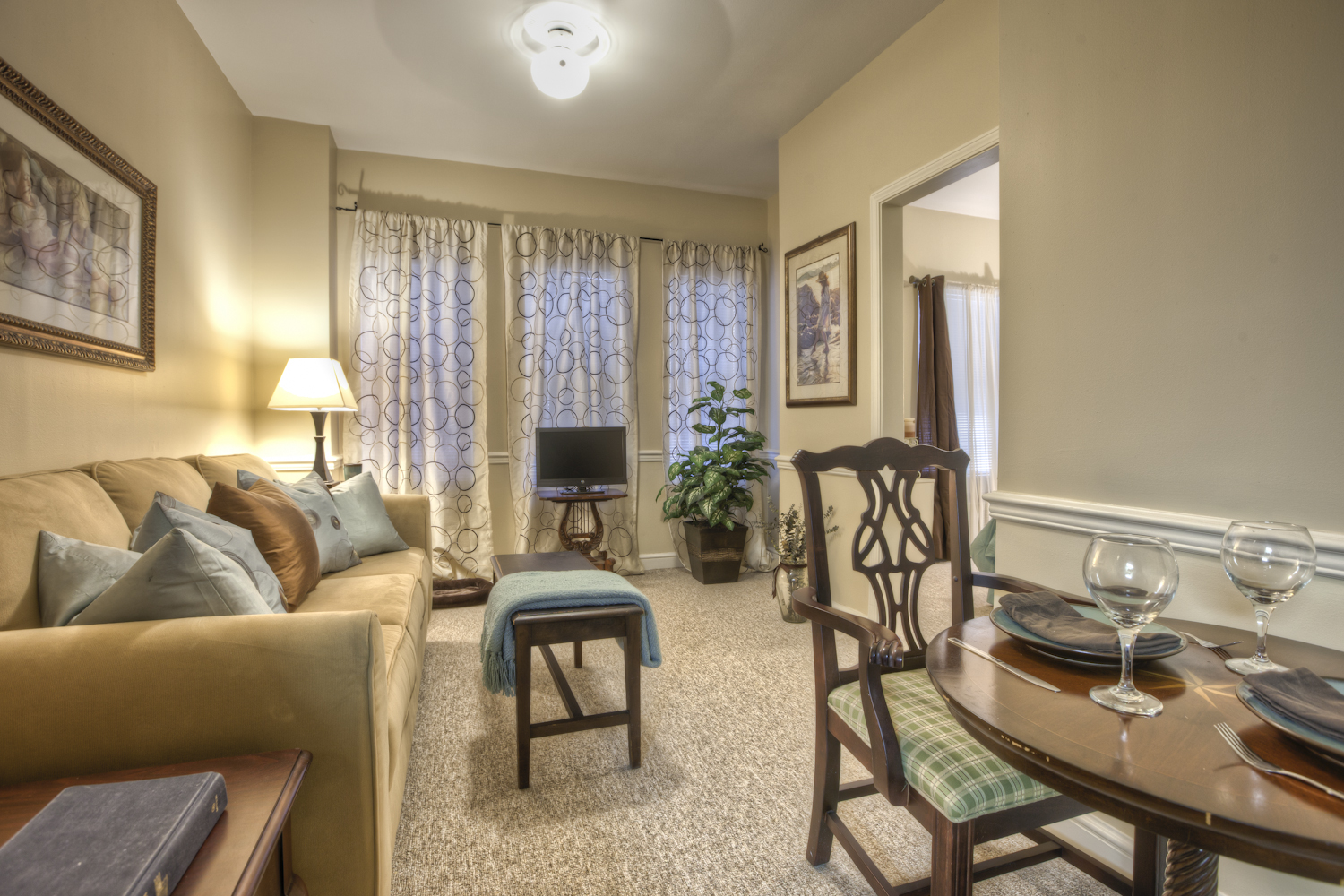
A living room in an independent living apartment.
Apartment Sizes
Independent living communities usually offer a greater variety of apartment sizes and styles than assisted living facilities or nursing homes. This means more one-bedroom and two-bedroom apartments compared to the large number of studio apartments in assisted living and skilled nursing.
For instance, in an independent living community the most common independent living apartment may be a one-bedroom with 550 sf of space, while the most common apartment in an assisted living community may be a 350 sf studio.
Downsizing can be difficult, so many seniors appreciate the extra space. They may use the extra space to store things such as a sewing machine or desk to work on, or they may want an extra bedroom in case the grandkids want to come visit for the night.
In a studio, the senior's living area and bedroom are in the same room. Studios are particularly common in memory care communities, nursing homes, and are sometimes included in independent living communities to provide a more affordable option. Newer independent living facilities, however, often offer one and two bedroom apartments, in addition to studios, for those seniors or couples that need more space.
In a one or two bedroom apartment, the senior has a living room area separate from the bedrooms. This arrangement may be more comfortable and familiar for the resident if the additional cost is not an issue.
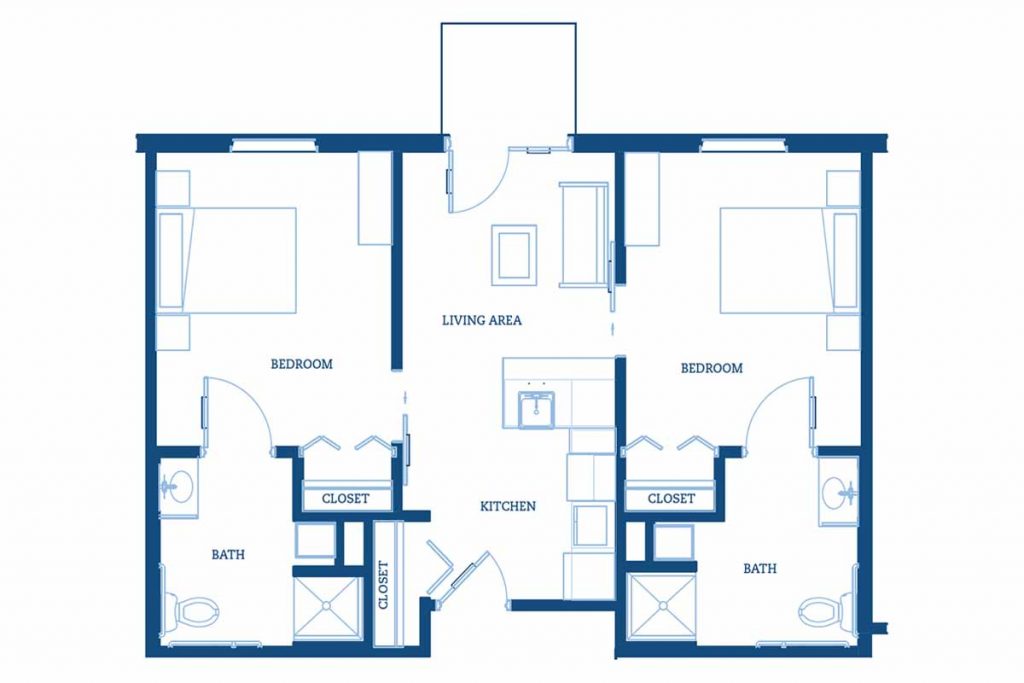
Independent living floor plan with two bedrooms and two baths
Kitchens
Kitchens are more common in independent living communities than other types of senior housing. For instance, many independent living apartments have full kitchens with a stove, sink, full refrigerator, and cabinet space. In communities that include three meals per day for all residents, a kitchenette is more common. A kitchenette usually excludes the stove, has less cabinet space, includes a microwave, and includes a smaller fridge.
Whether a full kitchen or kitchenette is right for you depends on how much you want to or like to cook or how much you need to cook based on the number of meals you'll be eating in the community's dining room.
Bathrooms
Independent living apartments include a full bathroom (sink, toilet, and shower). These bathrooms may be luxurious or plain, depending on the community. Many bathrooms include a roll-in shower and handicap bars.
In addition, many communities offer ADA compliant bathrooms for residents that have the most difficulty with mobility. The availability of ADA compliant bathrooms may be limited, and they may be in only a couple of apartments. So, check with the community to see if any are available in the apartment type that you want.
Closets
Do you have too many blouses to count? Closet space can be limited in independent living apartments. Some older senior living apartments may not have any closet space at all, or they may provide storage through a wardrobe. Newer luxury independent living apartments may offer full walk-in closets.
How is Independent Living Different From Other Types of Senior Living?
Independent living is about a maintenance free lifestyle with activities and events to enjoy with your peers. Assisted living, memory care, and skilled nursing are focused more on care and less on lifestyle.
Key Points
- 55+ or active adult communities are designed for very independent seniors around common amenities and activities (golf, tennis, croquet, swimming, etc.)
- Assisted living offers personal care services, but is otherwise similar to independent living
- Memory care is a type of assisted living, designed to assist those residents that suffer from dementia or Alzheimer's disease.
- Nursing homes residents need care 24/7 or are rehabilitating from an injury or surgery
How Does Independent Senior Living Differ From Assisted Living?
The differences between independent living and assisted living care can be subtle and confusing. Assisted living offers many of the same services including dining, housing, maintenance, transportation, and social activities that are offered in independent living.
Assisted living communities, however, offer personal care services to their senior residents as a primary function of the community, while independent living communities generally only offer these services through a third-party home care provider. That is the main difference between independent living and assisted living communities.
To make it more confusing, some independent living communities will license their apartments for assisted living. In this case, an independent living resident in an independent living apartment, can stay in that apartment and transition to become and assisted living resident once the senior needs personal care services, as long as that apartment is also licensed for assisted living.
Other communities will clearly distinguish independent living and assisted living areas of the campus, so the independent living apartments will be in one building and the assisted living apartments will be in another part of the building or in a separate building.
Regulations
Independent living communities are regulated primarily by building codes (fire, evacuation, elevator, construction, etc.), by insurance regulators for financial stability, and by health inspectors for dining sanitation and food safety.
Please note that if independent living communities do not offer assisted living, then they are not regulated by a department of health or other department for the purpose of reviewing personal care services. If the community uses a home health care company to provide personal care services, then the home health care company is regularly licensed and inspected.
Building Codes
Building code regulations are the largest group of regulations for independent living communities. These codes determine whether or not the community must have a fire suppression system, what structural and other improvements are required, what ingress/egress from the property must be maintained, how many non-ambulatory residents can live in certain sections of the building, and how the elevator is to be installed and maintained. In essence, all of these codes have to do with life safety.
Fire and safe ingress/egress are two of the biggest concerns with regard to life-safety in independent living. Nearly all new communities must have a sprinkler system, but some older communities do not. While relatively rare, fires in independent living communities do occur from time-to-time. Regardless of age of the building, confirm that the community that you're interested in has a sprinkler system that is tested regularly.
Insurance Regulations
CCRCs entrance fee requirement is often considered a type of insurance. This is because the entrance fees may be utilized to pay future unforeseen or anticipated expenses. For instance, if you need nursing care in the future then the entrance fee may be used to reduce your monthly out of pocket.
Since CCRCs will hold large sums of money due to the large entrance fees, and will have future obligations due to unknown risks, many states regulated them in a similar way to insurance companies. As a result, CCRCs have to provide annual updates on their financial condition to the state insurance regulators. The regulators job is to ensure that the CCRC is holding adequate funds to meet future obligations as residents need additional care or leave the community.
Dining Inspections
Similar to restaurants, most independent living communities are inspected to ensure proper sanitation and food safety in their kitchens and dining rooms.
Amenities and Activities
Independent living communities tend to have several amenities to attract prospective residents. For instance, some independent living communities offer a swimming pool, fitness center, movie theater, putting greens, computer lounges, pickleball courts, game rooms, billiards room, pub, theaters, and more. Assisted living communities may offer some of the same amenities, but they're more common in independent living.
Social calendars are often packed in many independent living communities as well. Some of those activities may include restaurant outings, trips to theaters, trips to sporting events, game nights, movie nights, fitness classes, volunteer opportunities, musical performances, Bible studies, and many more. Checkout the events calendar at the community to find out more. Many communities post photos of the social activities on their website or Facebook page, in case you're curious.
Housing Types / Sizes
Independent living apartments are usually larger than assisted living apartments. For instance, independent living apartments often range from 350 sf to 1,200 sf or more. Assisted living apartments are generally more in the 250 sf to 800 sf range.
Independent living apartments are also more likely to be one-bedroom or two-bedroom apartments as opposed to studios, which is the most common apartment type in assisted living. Senior residents might use the space for a favorite hobby, such as sewing or painting, or the space may provide a couple a little more room for all of their things.
Home Care in Senior Independent Living
To make it more confusing about the difference between assisted living and independent living, some independent living communities offer personal care services through home care. In fact, since an independent living apartment is technically the resident's home, home care for personal care services can be provided in any independent living apartment.
So, even if a community markets itself as an independent living community only, you should still be able to receive personal care services as you would in an assisted living community, except you'd need to contract with a third-party home care provider to receive those services.
Some independent living communities will offer a preferred third-party home care provider.
This is particularly true for independent living communities that don't offer assisted living and want to ensure seniors that they can get the care they need, even if their facility is not licensed for assisted living. The home care provider in this case would have the appropriate license.
Many seniors find it reassuring to know that care is available as their needs progress. The senior living industry calls the different care types available, depending on the seniors' care needs, a continuum of care.
Other communities will actively discourage the use of home care in independent living and may encourage residents to move to the assisted living wing of the community or to another community if they do not offer assisted living. This pressure may be the result of complaints by other independent living residents, or it may spring from a financial consideration.
How is Independent Living Different From Memory Care?
Memory care is actually a sub-type of assisted living. Similar to assisted living, memory care residents receive personal care services to help them meet their daily needs for grooming and other activities of daily living. However, memory care communities tailor these personal care services, and the community's environment, to the specific needs of those suffering from dementia or Alzheimer's.
Independent living communities do not provide for those who suffer from dementia or Alzheimer's. Independent living communities are also designed for a healthier, more independent average resident. This is in contrast to the memory care resident who has greater care needs.
Activities
The activities or events in the memory care community will be tailored specifically for those suffering from dementia. The community may offer music or other therapeutic activities. It may encourage general wellness through fitness classes for those suffering from dementia or Alzheimer's.
Secure Neighborhood
Most memory care communities or neighborhoods are secured or locked to prevent residents from wandering outside of the community. The purpose of securing this environment is to protect the residents.
Independent living communities do not need to offer this type of protection. They may offer daily check-ins, however, if a resident or family member would like someone to see if they're doing okay.
How are Senior Independent Living Communities Different From Nursing Homes?
Nursing home residents need care 24/7 or are rehabilitating from surgery or an injury. The care provided by a nursing home or skilled nursing facility is more medical in nature, and often requires highly-trained professionals such as R.N.'s and Physical Therapists.
Both independent living facilities and nursing homes provide basic housekeeping, dining, and personal care services, but the environment can differ greatly between the two.
Nursing homes are regulated at both the state and federal level. As a result of these regulations, nursing homes are typically more institutional in nature. Nursing homes in states with certificate of need law may face limited competition, since the law discourages the construction of newer competing communities.
In contrast, independent living communities are in a free market and face strong market forces to provide the absolute best amenities and experience possible to the residents.
Many nursing home communities are also much older, dating 30 years or older and have small rooms, institutional flooring and colors, and very limited amenities. These nursing homes may resemble a hospital more than a senior housing community. Given the differences, some people separate nursing homes into a different category called long-term care.
Who Pays for Independent Living?
In independent living communities, nearly all residents or their families are paying for themselves through social security, investment income, pension income, income from friends or family, or through an asset sale.
Most assisted living and memory care residents pay through the same means as independent living seniors. Although, some residents in assisted living or memory care will receive a Veterans' benefit to help pay, or a smaller portion of residents will be paid for by Medicaid Waiver.
Most nursing home care is paid for by Medicare (short-term rehabilitation) or by Medicaid (long-term care). However, if you have assets or substantial income, your state will require a spend down of your assets prior to paying for your nursing home stay with Medicaid.
Who Qualifies for Independent Living?
Key Points
- Beside age and ability to pay, there are no other requirements for independent living
- Independent living residents are generally more independent
- Most independent living residents are in their 80's, but some communities skew much younger (high 60's or low 70's at move-in)
Age and income are the only two primary requirements to move into independent living. Most communities have a legal requirement not to accept any residents below 55 or 62 years of age.
Some independent living communities will request that you prove the ability to pay for your stay in the community. This can be a bit intrusive for many seniors or their families, but it is really designed to protect the community from the one or two residents that try not to pay rent.
This income or asset test is most common in continuing care retirement communities and requires that you provide bank, social security, or asset statements to prove that you are capable of making the required payments.
What if I Need More Care?
If you need more care, then an assisted living facility or a nursing home may be a better fit for you. Those communities are designed to provide for seniors that need personal care services on a daily basis or that need more intensive 24/7 care.
What is the Average Age for Independent Living?
The average age for independent living residents is approximately 82. The typical legal age requirement is much younger: 55 or 62 years old.
Independent living communities with an active social scene and rich amenities often skew younger. Some senior independent living communities have residents that are in their late 60's or early 70's. The average age and activity level truly vary by community. You will have to spend some time in a community to see if you feel comfortable.
